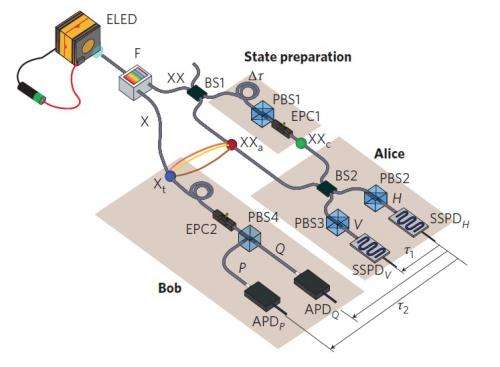March 15, 2013 feature
Quantum teleportation performed with light from a quantum dot embedded in an LED

(Phys.org) —In a new study, physicists have teleported photonic qubits made of pairs of entangled photons that are generated by an LED containing an embedded quantum dot. The novel set-up has advantages compared to the conventional method of generating entangled photons using a laser, and could lead to a simplified technique for implementing quantum teleportation in quantum information applications.
The researchers, J. Nilsson, et al., at Toshiba Research Europe Limited and the University of Cambridge, both in Cambridge, UK, have published their paper on demonstrating quantum teleportation using an LED in a recent issue of Nature Photonics.
As the scientists explain, quantum teleportation—a process in which quantum information is destroyed so that it may be transferred simultaneously to another location—has been proposed as a way to create quantum communication networks and quantum computing protocols despite the no-cloning theorem. According to the no-cloning theorem, quantum information cannot be copied. Although no-cloning enables quantum cryptography to have a high degree of security, it also limits the options to create quantum communication networks and increases the losses in quantum computing due to imperfect measurements.
Teleporting the information may offer a solution for these two areas. In quantum communication networks, teleportation can establish a quantum channel between two nodes. In quantum computing, teleportation can transfer qubits from successful logic operations, while the other qubits can be thrown out. Although quantum teleportation can be implemented with different systems, the researchers here argue that photonic qubits are best suited for the largest number of applications.
One of the most important parts of the photonic teleportation process is having a light source that produces single pairs of entangled photons. Although lasers can be used to generate the photons, they involve practical complexities and sometimes generate multiple photon pairs, and these problems have inhibited their use in quantum information technologies.
"We can also produce entangled photon pairs by pumping a non-linear crystal with a laser," coauthor Andrew Shields at Toshiba Research Europe Limited told Phys.org. "Although this has facilitated many experiments in quantum optics in the past, it has the disadvantage that the process sometimes produces two (or more) pairs. These multiple pairs cause errors in quantum information processing schemes that become increasingly problematic as we scale to larger numbers of photons. Thus developing true quantum light sources (i.e., one that produces just one entangled pair at a time) is seen as essential to achieving useful applications in quantum communications and photonic quantum computing."
As an alternative, the researchers here created an entangled-light-emitting diode (ELED) with an indium arsenide quantum dot to generate pairs of entangled photons one at a time. Using the ELEDs, the researchers demonstrated an average teleportation fidelity that exceeds the maximum that can be achieved using only classical correlations, proving the quantum nature of the teleportation. A key difference with this set-up compared with laser-based set-ups is that here the photons are generated electrically rather than optically. One benefit of electric generation is that the emission wavelength of the quantum dot can be easily tuned using electric fields, which could make it compatible with a wide range of input photons of different wavelengths.
"It is actually quite straightforward to embed a quantum dot in an LED," Shields said. "The quantum dot is formed by a self-organizing method during the growth of the semiconductor layers. The quantum dot is comprised of indium arsenide, which has a larger lattice constant than the gallium arsenide substrate. This results in a very thin layer (about 2 monolayers thick) self-assembling into quantum dots. After growing the rest of semiconductor structure, we are left with a layer of quantum dots embedded inside the LED."
The researchers hope that the ability of the ELEDs to generate single pairs of entangled photons, along with future improvements in light collection efficiency and entanglement fidelity, will lead to the realization of a variety of teleportation-based quantum information applications.
"Quantum teleportation is an important primitive in quantum information processing," Shields said. "We are planning to apply it to quantum communications and deterministic photonic quantum logic gates."
More information: J. Nilsson, et al. "Quantum teleportation using a light-emitting diode." Nature Photonics. DOI: 10.1038/NPHOTON.2013.10
Journal information: Nature Photonics
Copyright 2013 Phys.org
All rights reserved. This material may not be published, broadcast, rewritten or redistributed in whole or part without the express written permission of Phys.org.




















